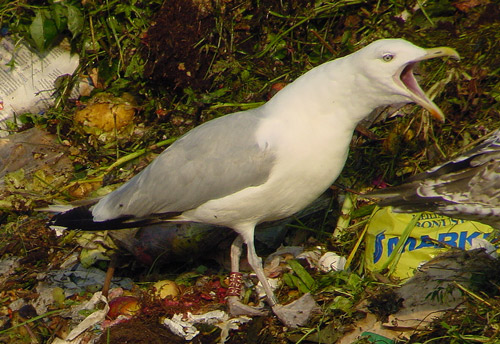 Herring
Gull - Zilvermeeuw (argentatus & argenteus): sub-adult August
Herring
Gull - Zilvermeeuw (argentatus & argenteus): sub-adult August
(last update: 08 december 2003)
Home
Links
to Gull Sites
Gull Taxa
Gull Topography
Grey & Colour Charts
Locations in NW Europe
Summaries of Articles
About ORG
@
(4 images) Herring Gull C154A 5cy (argentatus), August 12 2002, Tampere, Finland (61.31N,23.43E).
A 5cy argentatus, ringed dark red C154A as pullus on June 28 1998 in Pälkäne Finland. This 5cy bird shows only limited immature characteristics, especially on the primary coverts and the lesser coverts in the carpal edge. C154A is in active complete moult with the inner primaries P1-P6 fully grown, moulted to fifth generation. Primary P7-P8 are growing and P10 is still old. The median coverts are fresh grey feathers and the central greater coverts are dropped.
From June to December, 5cy argentatus
undergo a complete moult resulting in so-called "winter plumage". By August, the first
neat streaks can be found on the crown and hind-neck. After the complete moult is
finished by late autumn, the head will show extensive 'winter streaking', often
neat fine streaking in sub-adult argentatus.
By the end of the complete moult (first week of December), the scapulars, mantle
and all the wing-coverts will be replaced and sub-adult argentatus
will be hardly distinguishable from full adult plumage, except the black
centres of the primary coverts in some sub-adults. From June onwards, the new plain grey wing-coverts are
moulted in, starting with the outermost median coverts.
During the summer, the primaries are moulted to fifth generation. The faded brown fourth generation primaries (with only small white tips on P9-P10) are replaced for true adult primaries. In argentatus, the last outer primary P10 will be fully grown by early December, slightly later than in West-European argenteus. First data from Tampere, Finland, indicate that 3cy argentatus from this region are not delayed in primary moult compared to argenteus.
Adult northern argentatus show a different
pattern in the outer primaries, compared to argenteus. In
argentatus, especially from northern Scandinavia, the black marking
on P5 is very limited and, if black on P5 is present, this black has
diffuse edges. But often, these black sub-terminal markings are completely
lacking on P5. In Baltic argentatus populations, black on P5 is confined
to the outer-web, with sharply defined edges.
Argenteus normally has a black sub-terminal band on the top of p10,
dividing the tip from the mirror. If the black sub-terminal band on P10 is
broken, the outer-web of p10 still shows black marking. Argentatus
normally completely lacks sub-terminal markings, also on the outer-web of
P10. Some argentatus completely lack black on the edge of the
inner-web, creating a so-called "thayeri pattern".
The iris is clearly yellow in summer in most argentatus, but some sub-adult argentatus will keep the iris amber to dark brown.



